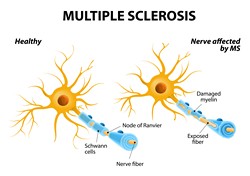Chromatin modification in multiple sclerosis
Regeneration of axonal myelination is an attractive approach for treating MS. This however, requires an in depth understanding of the process and the contribution of different cell types. It is now accepted that cell phenotype and fate is determined by the epigenetic state of a cell, which includes histone modifications and DNA methylation and controls key processes such as transcription. Oligodendrocytes (OL) are glial cells that mediate myelination of neurons and are derived from OL precursors. Regulation of OL precursor differentiation necessitates the concerted action of various transcription factors such as Sox2, Sox10 and Sox9. However, it is unclear, which transcriptional mechanisms of action are responsible, and whether differentiation involves the recruitment of epigenetic modulators such as chromatin-modifying enzymes. To address this, scientists of the EU-funded EPIOPC (Role of chromatin-modifying enzymes in oligodendrocyte precursor state in development and multiple sclerosis) project used animal models of MS and investigated the role of chromatin-modifying enzymes during OL development. In addition, they examined the heterogeneity of cells of the OL lineages and their transcriptional as well as epigenetic state. Their results identified that isoforms 2 and 3 of histone deacetylase (HDAC) bind to genes in neural stem cells (NSCs). HDACs remove acetyl groups from histone proteins and thus allow them to more tightly wrap DNA, rendering it inaccessible for transcription. Interestingly, the transcription factor Sox2 and HDAC2 were found to simultaneously bind to the regulatory regions of myelin-related genes. HDAC2 actively repressed OL differentiation of precursors and NSCs by inhibiting the transcription factor Sox10. From a therapeutic perspective, the consortium tested the effect of HDAC inhibition. In a rat model of experimental autoimmune encephalomyelitis, treatment with the HDAC inhibitor valproic acid and thyroid hormone ameliorated pathological symptoms. This indicated the potential of this approach in treating MS. Overall, the EPIOPC project uncovered some of the key molecular mechanisms of OL differentiation and myelination. The identified chromatin molecules could serve as targets for epigenetic-based therapies for demyelinating diseases such as MS.







